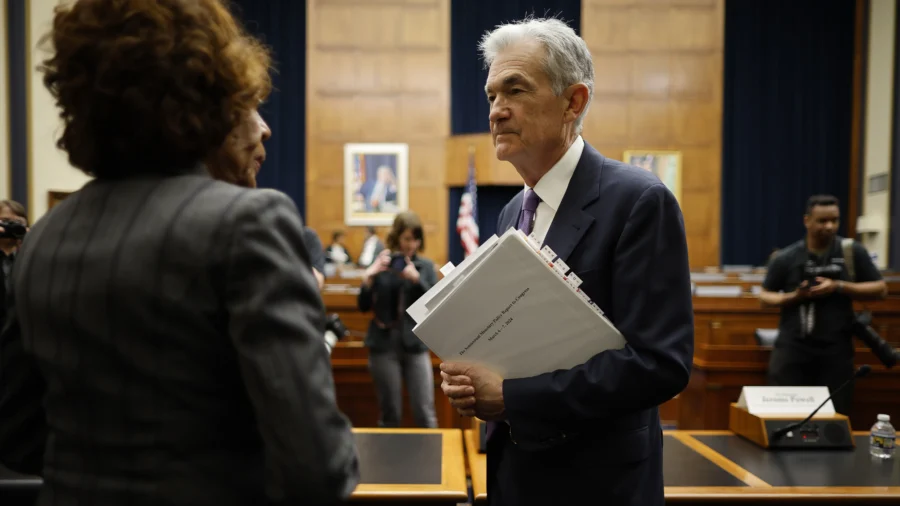Commercial real estate challenges are a “manageable problem,” but they could take “several years” to be resolved, Federal Reserve Chair Jerome Powell told lawmakers as financial markets monitor another potential bank failure.
Speaking before the House Financial Services Committee on March 6 to deliver his semi-annual monetary policy report, Mr. Powell reiterated his position that the stresses in the commercial real estate market will not lead to a wider calamity comparable to the 2008 global financial crisis.
He explained that this is a matter of market fundamentals. First, downtown real estate has too much office space as more employees work from home. Second, downtown retail “is no longer profitable.”
“Things like that are really at the heart of it,” Mr. Powell told lawmakers.
The central bank chief noted that “there will be losses by some banks,” particularly for small- and medium-size banks with higher commercial real estate concentrations. Financial institutions will need to have enough capital and liquidity and a plan to tackle this “problem” that will take “several years” to resolve, he said.
When asked about skepticism regarding officials’ casual attitude about growing problems festering in the sector, Mr. Powell responded by warning of “a risk that we would overreact to something” that was not as significant as the regional banking meltdown in March 2023.
“I am confident that we’re doing the right things there,” the Fed Chair said.
Last month, Mr. Powell told CBS’ “60 Minutes” that he is unconcerned about the U.S. witnessing a real estate-led banking crisis.
“It doesn’t appear to have the makings of the kind of crisis things that we’ve seen sometimes in the past, for example, with the global financial crisis,” he said.
While there is little risk of a repeat of 2008, Mr. Powell thinks some banks will “have to be closed or merged out of existence because of this.”
What Others Say
In recent months, top U.S. regulators have flagged commercial real estate market vulnerabilities that could threaten the financial system.
“CRE is the largest loan category among almost one-half of U.S. banks, and more than one-quarter of U.S. banks have CRE loan portfolios that are large relative to the capital they hold,” the Financial Stability Oversight Council wrote in its annual report in December. “The office sector faces the most severe challenges because demand for office space has been weak, particularly in the largest U.S. markets.”
The International Monetary Fund (IMF) has also weighed on U.S. commercial real estate, writing that it is a “risk” even at a time when investors are hoping for a soft landing.
“Financial supervisors must continue to be vigilant. Rising delinquencies and defaults in the sector could restrict lending and trigger a vicious cycle of tighter funding conditions, falling commercial property prices, and losses for financial intermediaries with adverse spillovers to the rest of the economy,” IMF staff stated.
“Ongoing monitoring and management of risks related to the sector will be important to mitigate potential risks to macro-financial stability.”
Treasury Secretary Janet Yellen told lawmakers at a February House Financial Services Committee hearing that commercial real estate is a worry, but financial regulators are on top of it.
“I’m concerned,” Ms. Yellen said. “I believe it’s manageable, although there may be some institutions that are quite stressed by this problem.”
One of these entities could be New York Community Bank Corp.
All Eyes on New York Community
The first anniversary of the Silicon Valley Bank and Signature Bank failures is approaching. One year later, the financial markets are examining another possible bank failure: New York Community Bancorp (NYCB).

NYCB shares plummeted more than 40 percent on March 6 on Reuters and Wall Street Journal reports that the company is seeking a cash infusion to shore up its balance sheet and “restore confidence.”
The stock, trading below $2, was halted for pending news.
Since the end of January, NYCB shares have tanked 82 percent as the firm grapples with multiple headwinds. The firm is one of the nation’s largest commercial real estate lenders, and nearly a third of its assets are concentrated in this sector.
Additionally, approximately one-third of NYCB’s deposits are uninsured. Analysts warn New York Community Bank could become a significant deposit flight risk. These fears have led to credit downgrades and negative outlooks by Fitch Ratings and Moody’s Investor Service.
Press Secretary Karine Jean-Pierre told reporters during a March 5 press briefing that the White House will monitor the situation and that financial regulators are on top of the issue.
Although it is difficult to determine if New York Community Bank is on the brink of collapse, “it certainly doesn’t seem like a winner” as there are plenty of “bad signs,” says Vijay Marolia, the CIO at Regal Point Capital.
“It’s very highly leveraged, and I don’t think anyone with gray hair would trust their valuations,” Mr. Marolia told The Epoch Times. “But of course, perceptions can become reality quickly in capital markets.”
Ultimately, it will depend on the balance sheet assets and the state of deposits.
Asked about the odds of the government intervening again, Mr. Marolia noted that this would not be a wise policy decision.
“It’s another ill-advised policy, in terms of banking regulation, that seems to have confused the management into ‘dropping the ball’ and not being able to report on time,” he said. “Remember, it all comes down to valuations, and free-moving capital markets are required to have accurate price data.”
The SPDR S&P Regional Banking ETF, an exchange-traded fund exposed to regional banks, slumped around 2 percent midweek. The investment vehicle is down about 8 percent year-to-date.
From The Epoch Times


